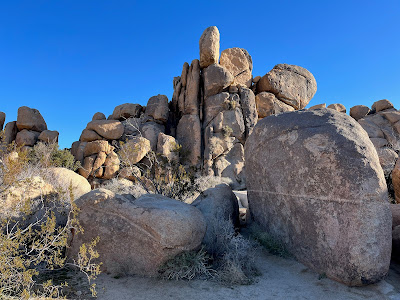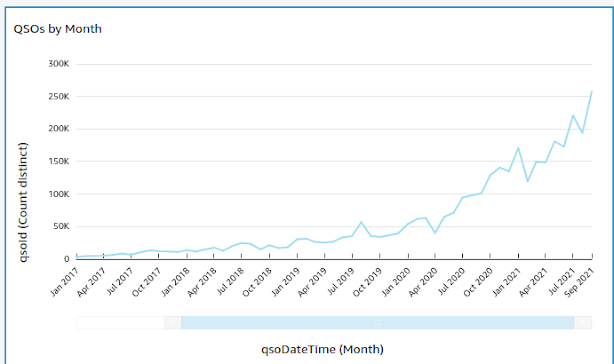Barriers and Balancing Acts
The National Park Service preserves unimpaired the natural and cultural resources and values of the National Park System for the enjoyment, education, and inspiration of this and future generations. The Park Service cooperates with partners to extend the benefits of natural and cultural resource conservation and outdoor recreation throughout this country and the world. -United States National Parks Service Mission Statement
In January of 2023, my wife and I visited Joshua Tree National Park for what was to be my third Parks on the Air activation at that site. The day before our trip to the desert, my wife and I watched a couple YouTube videos, including one produced by Allison Anderson. In the ten-minute video, Ms. Anderson shows a number of points of interest in the park, but almost more importantly, she shows off the AirBnB just outside the park's north entrance where she spent a couple nights while shooting. The video was beautifully shot, cleanly edited, and helpfully narrated. Watching it whetted our appetite for the next day's adventures. Ultimately, the day proved to be too cold for much sightseeing; we stuck to the comfort of me operating the radio next to a catalytic heater while my wife did some cross stitching in the relative warmth of our Volkswagen at one of the park's picnic areas. We did come away with some ideas for future visits when the weather is just a tad warmer, including places to explore and the possibility of an overnighter in a nearby AirBnB—thanks largely to Ms. Anderson's filmmaking.
For one pair of stakeholders in one experience, the video's existence seems to be furthering at least some of the stated goals of the National Parks Service (NPS). We were inspired to enjoy outdoor recreation—both on that January day and on some day to be determined in the near future. The possibility of a couple nights' stay in an AirBnB and maybe some restaurant meals in the town of Joshua Tree or nearby Yucca Valley wouldn't be too shabby for the local economy either. Nevertheless, if Ms. Anderson were to produce the same video today, she would run afoul of NPS regulations, and could face a hefty fine.
In a recent YouTube video, Jeven Dovey describes the NPS's new regulations that went into effect in the fall of 2022 requiring filming permits from all commercial filmmakers, including small crews producing content for YouTube and other social media platforms with the intent of monetizing that content. He goes on to describe the byzantine and often expensive set of rules governing how one goes about obtaining a permit. Each park has its own permitting process, and wait times are measured more on the scale of months than days. Nonrefundable application fees can run into the hundreds of dollars. In some cases, filmmakers are required to hire NPS monitors at their own expense to ensure that the production activities aren't damaging the park. At Death Valley National Park, which Mr. Dovey used as an example of the difficulty and expense of the permitting process, filmmakers are required to carry a million dollars in liability insurance.
As he sits facing the camera with his snapback hat turned backwards, Mr. Dovey's voice intones foreboding and doom as he dismisses the new regulations as "absurd". The presentation comes off as a bit unnuanced, but then again, he's not really there to fully present the issue in all of its complexity. That's not his job. The video appears to have been produced under the assumption that his primary audience is other YouTubers, and he's presenting information relevant to that audience in a way that they'll be receptive to. One can't reasonably expect that his audience would view the latest NPS policy as welcome news. If YouTubers were the only stakeholders in how our national parks are managed, that might be where it ends, but of course they're not. There are literally millions of stakeholders involved, all with their own version of how they want to enjoy the parks, and those interests are sometimes going to come into conflict. Moreover, most of those other stakeholders aren't there for the purpose of generating income, a distinction that's baked right into the NPS's ethos. A little bit deeper dive might be in order.
The Unites States has a wide variety of types of public land at the national, state, and local levels, each with their own agencies for managing those lands and each with their own set of priorities. Among these, national parks stand out; they're simply not like other public lands. The national parks of this country were created with the idea in mind that some places are so special that they should be free from commercial exploitation, preserved and protected now and for the future. How special? National parkland takes up about three and a half percent of the land mass of the United States. Certain commercial activities, like logging and mineral extraction, are strictly off limits. Other commercial activities require permits that intentionally are not easy to obtain. Visitors to national parks aren't there because they want to be in a place where there's a 7-Eleven or Panera on every corner, or because they want to see a working mine or a factory or a production company with its lighting equipment, caterers, and mobile dressing rooms filling up the landscape. This is the "preserv[ation]" and the "future generations" mentioned in the NPS's mission statement. At times these concerns about preservation can create tension with the goals of "enjoyment, education . . . and outdoor recreation" found in that very same mission statement. On one level, a video blogger is raising awareness in a way that can further the enjoyment of other visitors and prospective visitors; on another level, that same video blogger is impacting precious public resources for personal financial gain.
As if this balancing act weren't difficult enough, the very nature of filmmaking and other activities has dramatically changed in recent years. Much of the technological progress over the last few decades has had the effect of lowering barriers to entry in a number of fields. Virtually every musician nowadays has a home studio. Getting studio time, once the holy grail of any aspiring musician, is now simply a matter of going into a spare bedroom and closing the door. Getting one's written word published was once reserved for a select group of authors and journalists. Today any hack with a keyboard and some half-baked ideas can call himself or herself a blogger. Similarly, with readily available platforms like YouTube and TikTok, anyone with a decent camera and a willingness to learn to use editing software can be a filmmaker.
With the natural attractiveness of this country's national parks as a filming location, this proliferation of would-be filmmakers challenges the NPS's mission of preservation and the enjoyment of all park visitors. In short, managing the impact of filmmaking was much more straightforward when barriers to entry were higher. Mr. Dovey points out that the impact to the park of a single YouTuber isn't much more than that of a hiker or other park visitor. But if we look at the reduced barriers to entry, wrap them up in the tragedy of the commons, and sprinkle it all with a little of Kant's First Categorical Imperative, we quickly realize that the potential problem isn't just one YouTuber. A few dozen or a few hundred YouTubers, all looking for the one shot that will get them over the 100,000 subscriber mark, are almost certain to come into conflict with other park visitors, and potentially have a far greater impact on the park than even a few modestly sized professional production crews.
There are no easy answers. Content creators are in a position to get the word out about the majesty of America's national parks, which can translate into increased support for the NPS's mission as well as revenue from visitors. At the same time, the NPS is charged with ensuring that well-meaning content creators aren't detracting from other stakeholders' enjoyment of the very thing they're nominally promoting. Rules and regulations tend to lag behind reality. In time, we'll hopefully see the NPS's regulations catch up. A unified permitting process for all parks seems like an easy enough place to start. The million dollar insurance requirement at Death Valley is probably overkill for a small crew photographing the landscape with available light. As for the fees and the wait times, the reality is that there will likely be—particularly at the more popular parks—more applicants than could be accommodated without degrading the park experience for other stakeholders. How those permits are ultimately rationed is bound to make some people unhappy, but the NPS's unique mission is and will continue to be to manage our national parklands as the truly special places they are.



Comments
Post a Comment